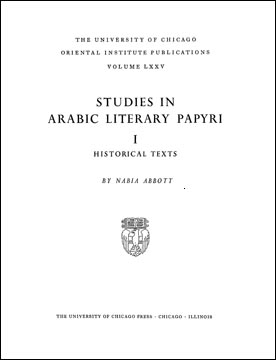OIP 75. Studies in Arabic Literary Papyri I: Historical Texts Nabia Abbott

The eight documents presented in this work (together with Oriental Institute No. 14046, previously published) form the main basis of the present study. They represent nine fields and periods of pre-Islamic and early Islamic history that range from the story of creation to military history in the tenth century of our era. The estimated dates of the papyrus fragments cover some two hundred years, roughly from about the mid-eighth to about the mid-tenth century. Furthermore, the documents represent, for the most part, the earliest Islamic historians, even though some are not yet identified. Again, each papyrus fragment is undoubtedly the earliest known existing manuscript of the work it represents. Still unidentified are the authors of Documents 1, 2, and 3, which deal with the story of creation, Adam and Eve, and Jewish legendary history respectively. Tentatively identified are Oriental Institute No. 14046 and Documents 5 and 8, which, in all probability, trace back respectively to the lost works of Wahb ibn Munabbih's legendary history, Ma'mar ibn Rashid's campaigns of Muhammad, and Abu Muhammad al-Faraghani's continuation of Tabari's history. On the other hand, Document 4 is definitely the earliest extant fragment of the well-known Sirah of Ibn Hisham, while Documents 6 and 7 represent the illusive Tarikh al-khulafa' of Ibn Ishaq and the little-known Dhikr al-Nabl of the Shi'ite Ibn 'Uqdah respectively. Both of these works were hitherto believed lost. These papyrus documents have a threefold significance. The group as a whole has some bearing on the early history of literary scripts and scribal practices. Again, the group, though some documents more than others, is significant either for its actual historical contents or for the light it throws, directly or indirectly, on the cultural trends of the Umayyad and early 'Abbasid periods. But the group's greatest significance is for the study of the scope and method of early Islamic historiography, evolving in a manuscript age.
- Oriental Institute Publications 75
- Chicago: The University of Chicago Press, 1957
- Pp. xiv + 123; 13 plates
- Hardbound 9.00 x 11.75 in
- Out of print

